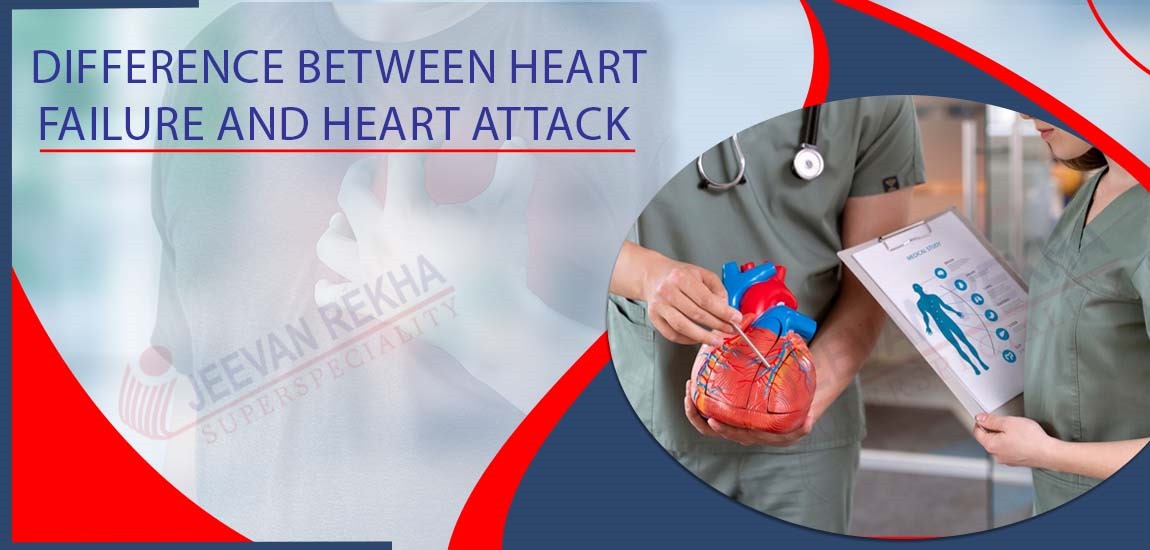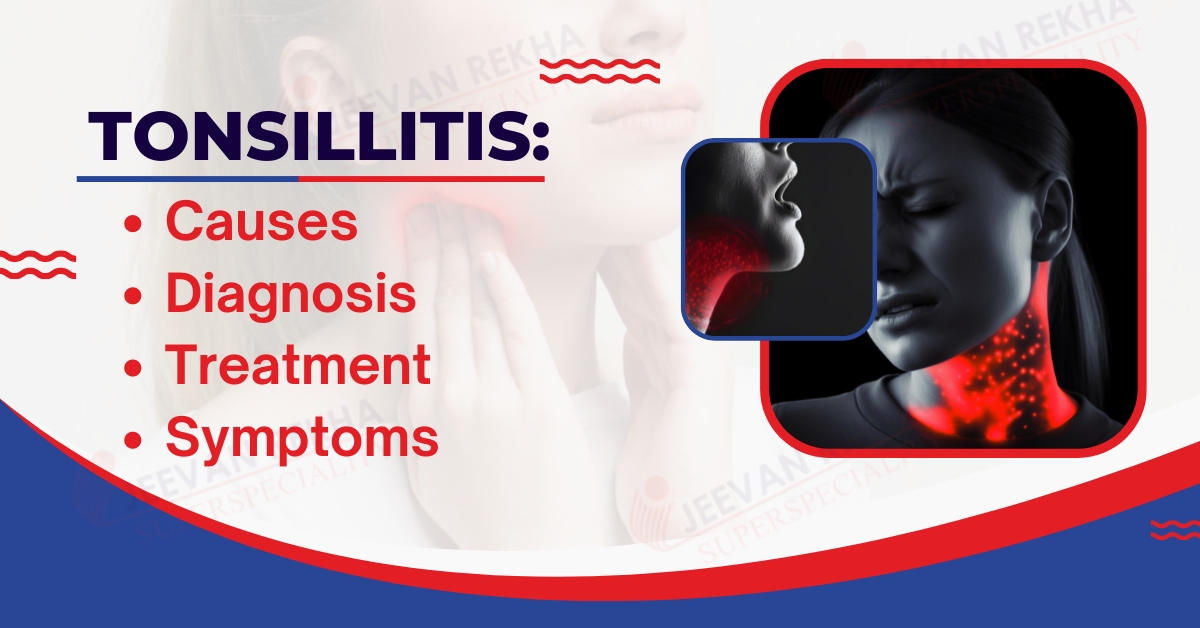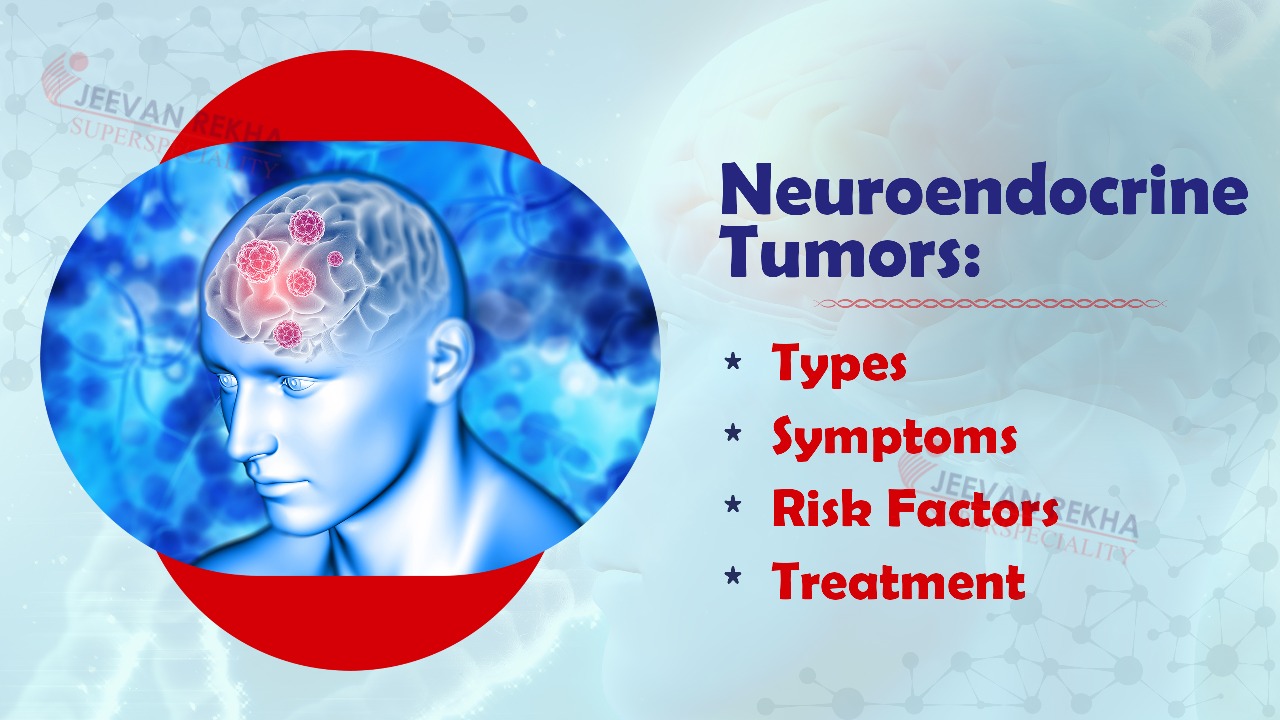
- By Admin
- In Health and Tips,
- Posted June 18, 2024
Difference Between Heart Failure and Heart Attack
Heart failure and heart attack are both serious cardiac conditions, but they have distinct causes and symptoms. Heart failure, often chronic, arises from the heart's diminished ability to pump blood efficiently, which can be due to factors such as persistent high blood pressure, coronary artery disease, or heart muscle damage from infections or toxins. Symptoms of heart failure include breathlessness, fatigue, leg swelling, and exercise intolerance.
Conversely, a heart attack, or myocardial infarction, typically occurs suddenly and results from a blockage in one or more coronary arteries, depriving a portion of the heart muscle of oxygen-rich blood. This blockage can lead to the death of heart tissue.
Heart Attack Causes:
Various factors contribute to plaque development and the risk of a heart attack. These risk factors include:
- High blood pressure (hypertension): This can damage the walls of the arteries, making them more prone to plaque buildup.
- High cholesterol levels: Elevated LDL cholesterol ("bad" cholesterol) can lead to plaque accumulation in the arteries.
- Smoking: The chemicals in tobacco smoke have the potential to harm blood vessels and encourage the development of plaque.
- Diabetes: People with diabetes are at higher risk of developing heart disease, including heart attacks.
- Obesity and physical inactivity: Being overweight or obese and not getting enough exercise can increase the risk of developing heart disease.
- Family history of heart disease: Genetics can play a role in predisposing individuals to heart attacks.
- Age and gender: The risk of heart disease, including heart attacks, increases with age, and men tend to have a higher risk at a younger age compared to women.
Heart Failure Causes:
Heart failure can have various underlying causes, and often it's a result of other conditions that have damaged or weakened the heart muscle. Common causes of heart failure include:
- Coronary artery disease (CAD): CAD is a condition where the coronary arteries, which supply blood to the heart muscle, become narrowed or blocked by a buildup of plaque. This reduces blood flow to the heart muscle, leading to damage over time and increasing the risk of heart failure.
- Heart attack (myocardial infarction): A heart attack occurs when blood flow to a part of the heart muscle is blocked, usually by a blood clot. If not treated promptly, a heart attack can cause permanent damage to the heart muscle, weakening its ability to pump effectively and potentially leading to heart failure.
- Hypertension (high blood pressure): Chronic high blood pressure can strain the heart by forcing it to work harder to pump blood throughout the body. Over time, this can lead to enlargement of the heart's chambers and weakening of the heart muscle, ultimately resulting in heart failure.
- Cardiomyopathy: This is a disease of the heart muscle itself, where the muscle becomes enlarged, thickened, or rigid, impairing its ability to pump blood effectively. Cardiomyopathy can be inherited or acquired due to other factors such as viral infections, alcohol abuse, or certain medications.
- Valvular heart disease: Problems with the heart valves, such as stenosis (narrowing) or regurgitation (leakage), can disrupt blood flow through the heart, leading to increased pressure and strain on the heart muscle, eventually resulting in heart failure.
- Heart defects present at birth (congenital heart defects): Some individuals are born with structural abnormalities in the heart that can affect its function and increase the risk of heart failure later in life.
- Infections: Certain infections, such as viral infections of the heart (myocarditis) or bacterial endocarditis, can cause inflammation and damage to the heart muscle, leading to heart failure.
- Other medical conditions: Conditions such as diabetes, thyroid disorders, obesity, and kidney disease can also contribute to the development of heart failure by placing additional strain on the heart or causing damage to the cardiovascular system.
Heart Attack Symptoms:
Heart attack symptoms can vary, but common signs include:
- Chest pain or discomfort: Often described as pressure, tightness, squeezing, or pain in the centre or left side of the chest. It may come and go or persist for more than a few minutes.
- Upper body discomfort: Pain or discomfort may radiate to the arms (usually the left arm but can also affect the right arm), back, neck, jaw, or stomach.
- Shortness of breath: Feeling breathless or having difficulty breathing, which can occur with or without chest discomfort.
- Nausea, vomiting, or indigestion: Some people may experience gastrointestinal symptoms, often mistaken for stomach upset.
- Cold sweats, lightheadedness, or dizziness: Feeling clammy, sweaty, dizzy, or lightheaded, which can occur along with other symptoms.
- Fatigue: Unusual fatigue or sudden onset of extreme tiredness, especially if it's unrelated to physical exertion.
Also read: What is Angina: Types, Symptoms, Causes, Risk factors and Treatments
Heart Failure Symptoms:
Heart failure symptoms can include:
- Shortness of breath: Especially during physical activity or when lying down flat, often described as difficulty breathing or feeling breathless.
- Weakness and fatigue: Experiencing unusually high levels of weakness or fatigue, even after resting.
- Swelling (oedema): Particularly in the legs, ankles, feet, or abdomen due to fluid buildup.
- Rapid or irregular heartbeat: Also known as palpitations, can occur due to the heart's inability to pump effectively.
- Persistent coughing or wheezing: Especially if accompanied by pink or bloody mucus.
- Reduced ability to exercise: Feeling easily fatigued during physical activity or unable to complete usual activities.
- Sudden weight gain: Due to fluid retention, which may be noticeable over a short period.
Diagnosis of Heart Attack & Heart Failure:
Diagnosing a heart attack (myocardial infarction) and heart failure typically involves a combination of medical history evaluation, physical examination, and diagnostic tests. Here's an overview of the diagnostic process for each condition:
Diagnosis of Heart Attack:
- Medical History and Physical Examination: The healthcare provider will ask about symptoms, risk factors, and medical history. They'll also perform a physical exam, including listening to the heart and lungs.
- Electrocardiogram (ECG/EKG): This test records the electrical activity of the heart and can help identify abnormalities indicative of a heart attack, such as ST-segment elevation or changes in the T wave.
- Blood Tests: When heart muscle cells are damaged, cardiac biomarkers like troponin are released into the bloodstream. Elevated levels of these biomarkers can indicate a heart attack.
- Imaging Tests: Imaging studies like echocardiography, cardiac MRI, or coronary angiography may be performed to assess the extent of damage to the heart and identify the location and severity of blockages in the coronary arteries.
Diagnosis of Heart Failure:
- Medical History and Physical Examination: Similar to the evaluation for a heart attack, the healthcare provider will inquire about symptoms, risk factors, and medical history, and conduct a physical exam focusing on signs of fluid retention, heart murmurs, or abnormal heart sounds.
- Blood Tests: Blood tests can help assess kidney function, electrolyte levels, and biomarkers such as B-type natriuretic peptide (BNP) or N-terminal pro-B-type natriuretic peptide (NT-proBNP), which are elevated in heart failure.
- Imaging Tests: Echocardiography (echo) is commonly used to evaluate heart function and structure, assess the pumping ability of the heart, and detect any structural abnormalities or valve problems. Other imaging modalities like cardiac MRI or CT scans may also be used for further evaluation.
- Electrocardiogram (ECG/EKG): An ECG can provide information about heart rhythm and detect any abnormalities suggestive of heart failure, such as atrial fibrillation.
- Stress Tests: These tests may be conducted to assess how well the heart functions during physical activity and can help diagnose heart failure and determine its severity.
- Cardiac Catheterization: This invasive procedure involves inserting a catheter into the coronary arteries to measure pressure and assess blood flow, helping to identify blockages or other issues contributing to heart failure.
Treatment of Heart Attack:
The treatment of a heart attack, also known as a myocardial infarction (MI), typically involves a combination of medical interventions aimed at restoring blood flow to the affected part of the heart, minimizing damage, and preventing future complications.
1. Emergency Medical Care:
Immediate treatment begins with emergency medical services (EMS) or hospital admission. Paramedics may administer medications and perform interventions such as oxygen therapy and cardiac monitoring en route to the hospital.
2. Medications:
- Aspirin: Given promptly to help prevent further blood clotting.
- Thrombolytic (clot-busting) therapy: Administered in certain cases to dissolve blood clots and restore blood flow.
- Antiplatelet drugs: Such as clopidogrel, ticagrelor, or prasugrel to prevent blood clots.
- Beta-blockers, ACE inhibitors, or ARBs: Medications to reduce the workload on the heart and prevent complications.
- Statins: Lipid-lowering drugs to reduce cholesterol levels and prevent future cardiovascular events.
3. Reperfusion Therapy:
- Percutaneous Coronary Intervention (PCI): Also known as coronary angioplasty with stent placement, this procedure involves inserting a catheter into the blocked artery to open it up and restore blood flow.
- Coronary Artery Bypass Grafting (CABG): In cases where PCI is not feasible or unsuccessful, bypass surgery may be performed to create new routes for blood flow around blocked coronary arteries.
4. Ongoing Medical Management:
- Cardiac Rehabilitation: A structured program of exercise, education, and counselling to help patients recover from a heart attack, manage risk factors, and improve overall cardiovascular health.
- Lifestyle Changes: Adopting a heart-healthy diet, quitting smoking, managing stress, and maintaining a healthy weight are essential for preventing future heart attacks.
- Medications: Long-term use of medications such as antiplatelet drugs, beta-blockers, ACE inhibitors, ARBs, and statins to manage risk factors and prevent recurrence.
5. Monitoring and Follow-Up:
Regular follow-up appointments with healthcare providers to monitor progress, adjust medications, and address any concerns. Diagnostic tests such as electrocardiograms (ECGs), echocardiograms, and stress tests may be performed to assess heart function and evaluate treatment effectiveness.
Treatment of Heart Failure:
The treatment of heart failure focuses on managing symptoms, improving quality of life, preventing disease progression, and reducing the risk of complications. Treatment strategies may include:
1. Medications:
- Angiotensin-converting enzyme (ACE) Inhibitors or Angiotensin Receptor Blockers (ARBs): These medications help relax blood vessels, reduce blood pressure, and improve heart function.
- Beta-Blockers: These drugs slow the heart rate, reduce blood pressure, and improve heart function.
- Diuretics: Also known as water pills, these medications help reduce fluid buildup and alleviate symptoms of fluid retention such as swelling (oedema) and shortness of breath.
- Aldosterone Antagonists: These drugs help reduce fluid retention and improve heart function.
- Sacubitril/Valsartan: A combination medication that is an alternative to ACE inhibitors or ARBs in certain patients with heart failure with reduced ejection fraction.
- Digoxin: Helps improve heart function and reduce symptoms in some patients with heart failure.
2. Lifestyle Modifications:
- Dietary Changes: Following a heart-healthy diet low in sodium (salt) and saturated fats can help reduce fluid retention and manage blood pressure.
- Regular Exercise: Engaging in regular physical activity as recommended by a healthcare provider can improve heart function and overall health.
- Smoking Cessation: Quitting smoking can help reduce the risk of further damage to the heart and blood vessels.
- Limiting Alcohol: Excessive alcohol consumption can worsen heart failure symptoms and should be limited or avoided.
- Weight Management: Maintaining a healthy weight can reduce strain on the heart and improve symptoms of heart failure.
3. Device Therapy:
- Implantable Cardioverter-Defibrillator (ICD): This device monitors heart rhythm and delivers an electrical shock to restore normal rhythm if a life-threatening arrhythmia occurs.
- Cardiac Resynchronization Therapy (CRT): Also known as biventricular pacing, this therapy involves implanting a device that coordinates the contractions of the heart's chambers to improve pumping efficiency.
- Left Ventricular Assist Device (LVAD): In advanced heart failure cases, an LVAD may be implanted to help pump blood from the left ventricle to the rest of the body.
4. Surgery:
- Heart Valve Repair or Replacement: In cases where heart failure is caused by heart valve problems, surgery may be necessary to repair or replace the affected valve.
- Heart Transplantation: For severe, end-stage heart failure that is unresponsive to other treatments, heart transplantation may be considered.
- Regular Monitoring and Follow-Up: Routine check-ups with a healthcare provider are essential to monitor heart function, adjust medications, and address any changes in symptoms or health status.
Tags
Blog Search
Latest Posts
-
5 Tips for a Happy and Healthy Summer
February 27, 2025 -
Body Ache (Pain): Causes, Symptoms and Treatment Options
February 10, 2025 -
Fatigue and Exhaustion: Causes, Symptoms, and Treatment
January 08, 2025 -
Testicular Health: Essential Facts and Care Tips for Men
December 27, 2024 -
Neuroendocrine Tumors: Types, Symptoms, Risk Factors & Treatment
December 26, 2024




